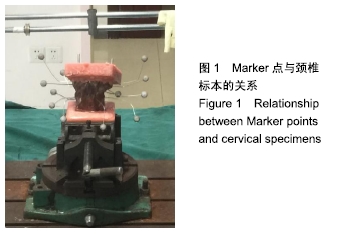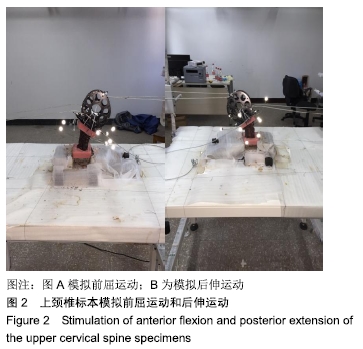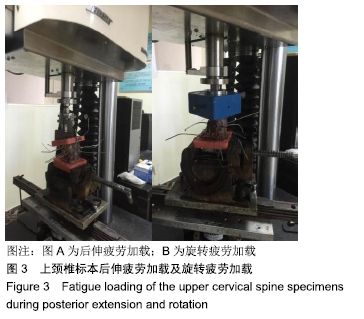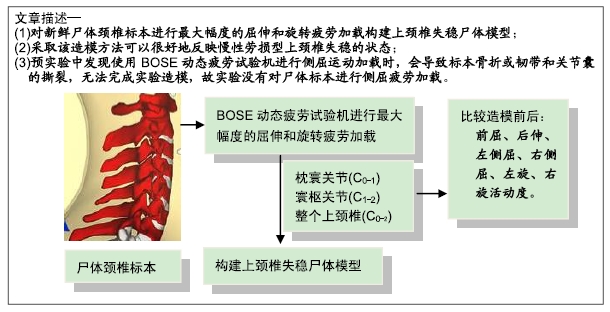中国组织工程研究 ›› 2020, Vol. 24 ›› Issue (20): 3152-3156.doi: 10.3969/j.issn.2095-4344.2610
• 脊柱组织构建 spinal tissue construction • 上一篇 下一篇
基于筋束骨理论建立慢性劳损型上颈椎失稳尸体模型及评价
梁 龙1,于 杰1,2,魏 戌1,2,周帅琪1,3,尹逊路1,2,刘广伟2,谢 瑞1,谢 榕1,3,庄明辉1,朱立国1,2,冯敏山1,2
- 1中国中医科学院望京医院脊柱二科,北京市 100102;2中医正骨技术北京市重点实验室,北京市 100102;3北京中医药大学,北京市 100029
Establishment and evaluation of a cadaveric model of chronic strain-induced upper cervical spine instability based on fascia-bone theory
Liang Long1, Yu Jie1, 2, Wei Xu1,
2, Zhou Shuaiqi1, 3, Yin Xunlu1, 2, Liu Guangwei2,
Xie Rui1, Xie Rong1, 3, Zhuang Minghui1, Zhu
Liguo1, 2,
- 1Second Department of Spine, Wangjing Hospital, China Academy of Chinese Medical Sciences, Beijing 100102, China; 2Beijing Key Laboratory of TCM Bone Setting, Beijing 100102, China; 3Beijing University of Chinese Medicine, Beijing 100029, China
摘要:
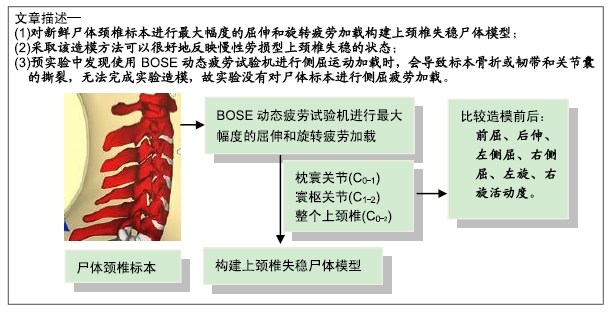
文题释义:
慢性劳损所致的上颈椎失稳:是由于长期累积性力引起颈部筋伤,筋不束骨,最终发生“筋出槽,骨错缝”,导致上颈椎活动度的异常改变。
“筋束骨”理论:“诸筋者,皆会于节”“宗筋主束骨而利机关也”等论述均表明筋能聚于关节附近维持关节的稳定性。当筋长期劳损后,出现“筋伤”,进而“束骨”能力下降,最终导致“骨错缝”的发生。
背景:对于上颈椎失稳机制的尸体标本研究多集中于急性暴力模型,尚缺乏慢性劳损型上颈椎失稳模型。
目的:根据“筋束骨”理论构建慢性劳损致上颈椎失稳尸体模型并进行模型评价。
方法:将9具新鲜尸体颈椎标本准备完毕后,先用Motion Analysis运动捕捉系统进行正常椎体活动度的检测,再使用BOSE动态疲劳试验机进行最大幅度的屈伸和旋转疲劳加载构建上颈椎失稳尸体模型,再次进行活动度的检测,比较造模前和造模后的上颈椎模型的枕寰关节、寰枢关节和整个上颈椎结构的前屈、后伸、左侧屈、右侧屈、左旋、右旋活动度。研究方案的实施符合南方医科大学的相关伦理要求,标本供者自愿捐赠。
结果与结论:①在前屈运动时,造模后标本的寰枢关节(C1-2)、整个上颈椎(C0-2)活动范围明显大于造模前的标本(P < 0.05);后伸时,造模后标本的寰枕关节(C0-1)、整个上颈椎(C0-2)活动范围明显大于造模前(P < 0.05);在屈伸复合运动时,造模后标本的寰枢关节(C1-2)、整个上颈椎(C0-2)活动范围显著大于造模前标本(P < 0.05);②在侧屈活动中,造模后标本寰枕关节(C0-1)、寰枢关节(C1-2)、整个上颈椎(C0-2)的活动度均较造模前有所增大,但差异无显著性意义(P > 0.05);③在右旋活动时,造模后标本的整个上颈椎(C0-2)的活动度较造模前明显增加(P < 0.05);④在左右旋复合运动时,造模后标本的寰枢关节(C1-2)、整个上颈椎(C0-2)活动范围明显大于造模前的标本(P < 0.05);⑤结果说明,采取该造模方法可以很好地反映慢性劳损型上颈椎失稳的状态。
ORCID: 0000-0001-7193-8547(梁龙)
中国组织工程研究杂志出版内容重点:组织构建;骨细胞;软骨细胞;细胞培养;成纤维细胞;血管内皮细胞;骨质疏松;组织工程
中图分类号:



